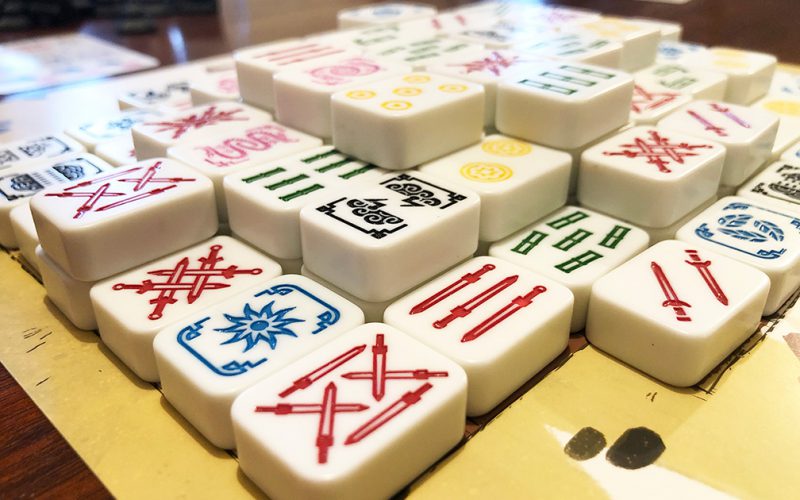This game review was originally published in Tumbleweird , January 2020.
Dragon Castle is an abstract strategy game for 2-4 players where players work independently to build a new city from the ruins of an ancient temple. The player with the city containing the most impressive array of consolidated districts and the tallest shrines wins. As with most abstract strategy games though, the theme is virtually non-existent. This a game where you’ll be dismantling a pile of Mahjong tiles and using them to score the most points by placing them in strategic configurations on your player board.
To start, players pick a tower configuration from the rulebook (or make one up themselves) and configure the Mahjong tiles in stacks of 1-3 tiles to make a central pool. Each player takes their own player board and a shrine. Shuffle and draw one card from the Dragon and Spirit decks, then stick the rest back in the box. The Dragon card will give the game a bonus objective, and the Spirit card will grant players a power that they can use during their turn. Dragon and Spirit cards are for the use and benefit of all players. A stack of countdown tokens is used based on the number of players and will be used as the game progresses to control when the game ends.
A player’s turn consists of one of three actions, all of which begin by taking one of the available Mahjong tiles from the top-most tier of the central pool (available tiles are tiles that have one long-edge free of an adjacent tile). Then, the player can either select a second available tile from any tier that matches the first one identically, take a shrine, or discard the initial tile by placing it face down near their player board and taking a victory point.
If the player has not discarded their tile, they can then place any tiles collected onto their player board in any space that is either empty or has a previously placed tile face-down. If placement of these tiles results in a pattern consisting of 4 or more tiles of the same colors touching, all of these tiles are flipped over and scored based on quantity (more tiles for more points). Additionally, depending on the color of tiles flipped, a number of shrines can be placed on top of flipped tiles. Tiles with shrines on them can no longer be built upon but will be scored for additional points at the end of the game.
Once the top two tiers from the central pool have emptied, on their turns players can instead opt to take a countdown token earning two victory points and hastening the end of the game. Once the game ends, points are scored based on collected victory point tiles, height of shrines and any Dragon card bonus conditions that apply; most points wins.
Player boards and tokens are pretty standard card stock and chipboard, but the illustration and watercolor landscapes throughout are lovely. The best components though are the Mahjong tiles that players will be handling throughout the game. They’re lovely to look at, and while what you build won’t really look like a city, it’s still visually compelling.
Dragon Castle is great for folks who are more interested in gameplay than but still want more visual appeal than most abstract strategy games tend to have. Totally worth a play.
Designed by: Hjalmar Hach, Luca Ricci, Lorenzo Silva
Player Count 2-4
Playtime: 30-45 Minutes
Time to Learn: 5 minutes
Complexity 2/5
Replayability: 4.0/5
MSRP: $50
Am I happy I bought it?: Definitely. Dragon Castle is an enjoyable game with strong table presence. It’s easy for newer players to pick up and rewards repeated play. Set up is super-fast so playing it once or twice in a sitting isn’t difficult to accomplish.
Written by Brendan Quinn; President of Tri-City Area Gaming. Learn more about the 200+ annual gaming events we host by visiting http://www.tricityareagaming.com.

